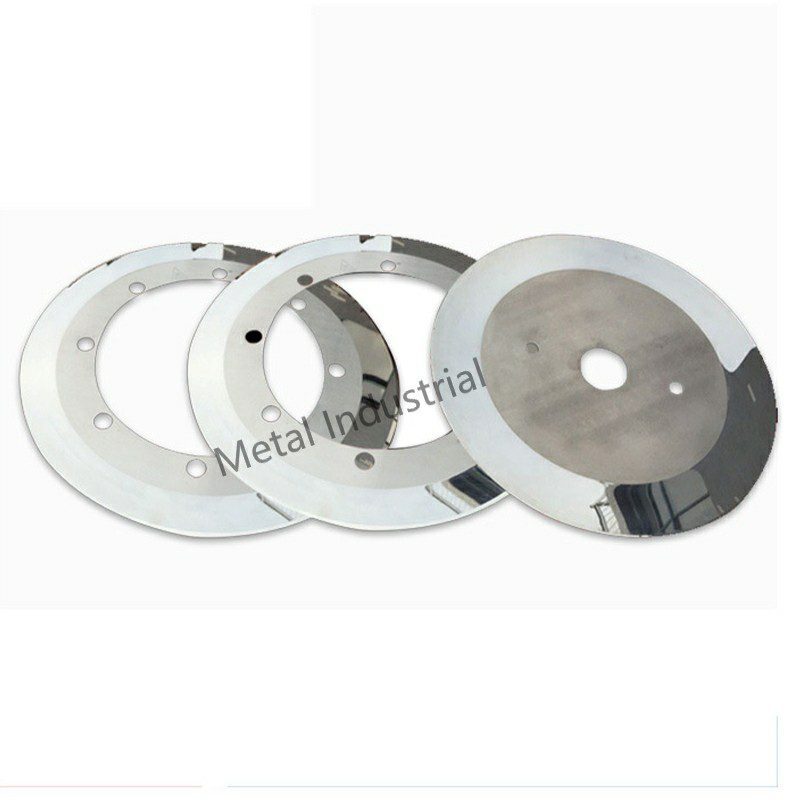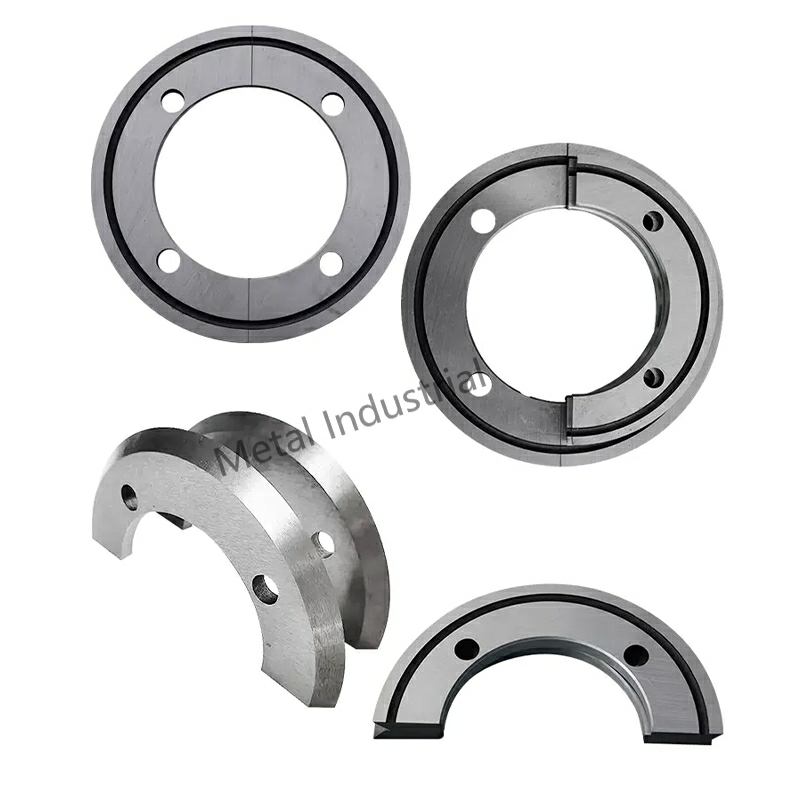
Rotary slotter blades are vital industrial machine blades widely used in the packaging industry for cutting, slotting, and scoring corrugated cardboard boxes with exceptional speed and precision. Nanjing Metal, a leading manufacturer, offers high-quality rotary slotter blades that help operators significantly enhance both productivity and product quality. Recent advancements from Nanjing Metal demonstrate remarkable improvements:
| Metric | Value/Improvement |
|---|---|
| Productivity | Increased by 500% |
| Fatigue Resistance | Improved by 300% |
| Die Cutter Load Capacity | Increased by 60% |
Choosing the right rotary slotter blades, including custom blade options from Nanjing Metal, enables professionals to achieve efficient and reliable packaging solutions. For more information or to discuss your specific needs, please contact Nanjing Metal directly.
Key Takeaways
- Rotary slotter blades cut, slot, and score cardboard quickly and precisely, helping make strong, well-shaped boxes.
- Choosing the right blade design and material, like high-speed steel or alloy steel, improves cutting quality and blade life.
- Custom blades fit specific machines and tasks, boosting efficiency and reducing downtime in packaging production.
- Proper installation, regular cleaning, and timely blade replacement keep machines running smoothly and maintain product quality.
- Using advanced rotary slotter machines with quality blades saves costs, increases productivity, and supports diverse packaging needs.
Rotary Slotter Blades Overview
What Are Rotary Slotter Blades?
Rotary slotter blades play a key role in the packaging industry. These blades belong to a group of industrial cutting tools designed for use in high-speed machines. Operators use rotary slotter knives to cut, slot, and score corrugated cardboard sheets. The sharp edges of these knives allow for clean and accurate cuts, which helps create boxes and cartons with precise dimensions. Rotary slotter knives often work in pairs or sets, rotating in sync to process large sheets quickly. This process supports mass production and ensures consistent quality.
Rotary slotter knives come in different shapes and sizes. Some have straight edges, while others feature curved or wavy designs. Each type serves a specific purpose in the packaging process. For example, straight rotary slotter knives make clean, linear cuts, while wavy knives create perforations or decorative edges. The choice of blade depends on the packaging design and the type of material being processed.
Aliases and Industry Terms
The packaging industry uses several terms to describe rotary slotter knives. Some professionals call them slotting knives or slotting blades. Others refer to them as die-cutting knives, especially when discussing their use in die-cutting operations. In some factories, workers might mention combined rotary slotter knives, which refers to blades that perform multiple functions, such as cutting and creasing, in a single pass.
Tip: Understanding these terms helps professionals communicate more effectively with suppliers and machine operators.
A few common aliases and related terms include:
- Slotting knives
- Slotting blades
- Die-cutting knives
- Combined rotary slotter knives
- Rotary cutting knives
These terms often appear in technical manuals and equipment catalogs. Knowing the correct terminology ensures that packaging professionals select the right rotary slotter knives for their machines.
Rotary Slotter Machine Principle
A rotary slotter machine uses a set of rotating shafts to drive the rotary slotter knives. The machine feeds sheets of corrugated cardboard between these shafts. As the cardboard passes through, the knives rotate and cut slots or score lines at precise locations. This action prepares the cardboard for folding and assembly into boxes.
The rotary slotter machine relies on accurate alignment and timing. Each rotary slotter knife must match the speed and position of the moving cardboard. Operators adjust the machine to control the depth and location of each cut. Some machines use combined rotary slotter knives to perform several tasks at once, such as cutting, creasing, and perforating. This approach increases efficiency and reduces the need for multiple machines.
Rotary slotter knives also play a role in die-cutting processes. In these cases, the knives work with other cutting tools to create complex shapes or patterns in the cardboard. The combination of rotary slotter knives and die-cutting technology allows manufacturers to produce a wide range of packaging designs.
Note: Proper maintenance of rotary slotter knives ensures smooth operation and extends the life of the rotary slotter machine.
Features of Rotary Slotter Knives
Rotary slotter knives stand out as essential components in packaging machinery. These blades help operators achieve precision cutting and maintain high accuracy during box production. Understanding the different blade designs and materials helps packaging professionals select the right rotary slotter knives for their needs.
Blade Design Types
Straight Blades
Straight rotary slotter knives provide clean, linear cuts. Operators often use these blades for standard slotting tasks. The simple structure of straight blades allows for easy maintenance. These blades deliver high accuracy, making them ideal for applications that require precise measurements.
Curved Blades
Curved rotary slotter knives handle rounded or irregular slots. Packaging designers choose these blades when they need unique shapes for custom boxes. Curved blades offer flexibility in application. They work well for projects that require more than just straight lines.
Wavy Blades
Wavy rotary slotter knives create perforations or decorative edges. These blades often appear in specialty packaging. Wavy blades help make tear lines or unique edges that stand out on the shelf. Operators use them when they want to add a special touch to packaging.
Tip: Selecting the right blade design ensures the rotary slotter knives match the packaging requirements and improve production efficiency.
Common Materials
High-Speed Steel (HSS)
High-speed steel rotary slotter knives offer superior wear resistance. These blades perform well in high-volume production environments. Operators rely on HSS blades for long-lasting performance and consistent results.
Alloy Steel
Alloy steel rotary slotter knives balance performance and cost. Many packaging facilities use these blades for standard applications. Alloy steel provides good durability and supports a wide range of slotting tasks.
Carbon Steel
Carbon steel rotary slotter knives serve as an economical choice. These blades work best for low-intensity or short-term use. Operators select carbon steel when they need a cost-effective solution for less demanding jobs.
Rotary slotter knives, available in various designs and materials, help packaging professionals achieve the best results. The right choice of rotary slotter knives ensures smooth operation and high-quality finished products.
Carton Slotter Blades Applications

Slotting and Scoring
Process and Principle
Carton slotter blades play a key role in the carton manufacturing process. Operators use these blades to cut slots and score lines on corrugated cardboard sheets. The rotary slotter knives rotate at high speed inside a high-efficiency carton slotting machine. The machine feeds the cardboard through the blades. The blades create straight slots for folding and assembly. Scoring makes shallow lines that help the cardboard bend without breaking. This step ensures boxes fold neatly and hold their shape.
Typical Blade Materials and Their Pros & Cons
Manufacturers often choose high-speed steel or alloy steel for slotting and scoring. High-speed steel rotary slotter knives provide high efficiency and last longer in high-volume production. Alloy steel blades offer a balance between cost and durability. Both materials help maintain clean cuts and precise scores. Operators select the right material based on the needs of the carton manufacturing process.
Creasing and Perforating
Process and Principle
Carton slotter blades also handle creasing and perforating tasks. Creasing creates fold lines that guide the cardboard during box assembly. Perforating makes small holes or tear lines, which help users open packages easily. Rotary slotter knives in a high-efficiency carton slotting machine perform these actions quickly and accurately. The process supports many packaging designs, including those that need easy-open features.
Typical Blade Materials and Their Pros & Cons
Alloy steel works well for repeated creasing and perforating. It offers strength and flexibility for different packaging needs. Carbon steel provides an economical option for short-term or low-intensity jobs. Both materials support the die-cutting process in the packaging industry.
Blade Materials by Application
Slotting and Scoring
| Application | Blade Material | Features |
|---|---|---|
| Slotting & Scoring | High-speed steel | High efficiency, precision, wear resistance |
| Alloy steel | Balanced cost and performance |
Creasing and Perforating
| Application | Blade Material | Features |
|---|---|---|
| Creasing & Perforating | Alloy steel | Durable, flexible |
| Carbon steel | Cost-effective for short-term use |
Operators in the packaging industry rely on carton slotter blades for every step of the carton manufacturing process, from slotting and scoring to creasing and perforating. Rotary slotter knives and die-cutting tools help create strong, functional boxes for many uses.
Custom Blades & Auto Rotary Slotter

Benefits of Customization
Custom rotary slotter blades play a vital role in modern packaging. Every packaging line has unique needs. Standard blades may not fit every machine or carton design. Custom blades help operators achieve optimal performance by matching the exact requirements of each production line. Many factories use auto rotary slotter machines to boost speed and accuracy. These machines need blades that fit perfectly and work with advanced features.
Custom blades support high efficiency in carton production. Operators can choose blade shapes, sizes, and materials to match their packaging goals. Customization allows for special designs, such as combined rotary slotter blades, which can cut, crease, and perforate in one pass. This reduces downtime and increases output. Industry reports show that custom design high-speed carton printing slotting die cutting machines use full automation and advanced vacuum transfer technology. Adjustable feeding systems and PLC electric adjustments make these machines reliable and efficient. Customization options and after-sales services, like installation and training, also show strong demand for custom blades.
Auto rotary slotter machines offer many benefits. Servo motor control and automation reduce manual work. The machines can handle different carton sizes and thicknesses. This flexibility helps factories meet the needs of ecommerce and retail packaging. Energy-saving features and independent slotting motors lower costs and extend machine life. Automatic adjustments for box heights and materials keep production running smoothly. These features show why custom blades are important for optimal performance in auto rotary slotter systems.
Nanjing Metal Solutions
Nanjing Metal stands out as a trusted industrial blade supplier and manufacturer with 18 years of experience in the industry. The company has a skilled design and manufacturing team focused on custom industrial blades. Nanjing Metal uses advanced CNC equipment and strict quality checks to ensure every blade meets high standards. The team offers design modifications to improve blade performance for each customer.
Quality control at Nanjing Metal includes first article inspection, certified material checks, and final inspections. The company provides real-time production updates and supports overseas monitoring. Customers receive fast quotes and a smooth import process. These practices have earned Nanjing Metal industry recognition as a reliable rotary slotter blades supplier. For more information or to discuss your needs, reach out to their sales engineers through their contact page.
Selection & Maintenance

Choosing the Right Blade
Assessing Packaging Requirements
Operators must first understand the specific needs of their packaging line. Different machines and products require different rotary slotter blades. For example, high-speed lines for retail cartons may need blades that support fast automation and multi-color printing. The table below compares several popular systems and their features, helping users match blade choices to their operational data:
| Manufacturer / Model | Printing Speed | Automation Level | Key Advantages | Typical Applications |
|---|---|---|---|---|
| Keshenglong & Shinko (6+1) | Up to 350 sheets/min | High | High precision, fast changeover | Multi-color retail, jumbo cartons |
| Bobst MASTERFLEX-HD | Up to 14,000 sheets/hr | High | Superior print quality, fast setup | High-quality retail packaging |
| Dong Fang Topra GD | High-speed | Full-line digital | Full automation, energy efficient | Bulk shipping, e-commerce |
| Mitsubishi EVOL 100/400 | Up to 400 boxes/min | High | Precise feeding, durable construction | Large-scale consumer goods |
| EMBA 245 QS | Up to 22,000 boxes/hr | High, green | Low waste, energy saving | Eco-friendly, high throughput |
Matching Blade Material to Application
Selecting the right blade material ensures optimal performance. High-speed steel works well for high-volume, precision tasks. Alloy steel offers a balance of durability and cost. Carbon steel fits short-term or less demanding jobs.
Considering Blade Size and Compatibility
Operators should check that the blade size matches the machine’s specifications. Compatibility with the rotary slotter ensures smooth operation and reduces downtime.
Evaluating Cost vs. Performance
Users should weigh the initial investment against long-term benefits. Blades that last longer and maintain accuracy may cost more but reduce replacement frequency.
Installation & Adjustment
Proper Blade Orientation
Correct orientation during installation and setup prevents uneven cuts. Operators should always follow the machine’s guidelines.
Securing the Blade
- Turn off the machine and remove old blades.
- Clean the mounting area.
- Align knife holders using alignment gauges.
- Secure the rotary slotter knives with hex wrenches, tightening screws evenly.
- Manually rotate the shaft to check for smooth movement.
Alignment and Calibration
Operators must calibrate blade depth based on cardboard thickness. Regular checks help maintain optimal performance.
Safety Checks Before Operation
Always use gloves and goggles. Inspect for proper alignment and secure fastening before starting the machine.

Maintenance Tips
| Maintenance Aspect | Recommended Routine | Outcome |
|---|---|---|
| Cleaning | After every 10,000 cuts | Maintains cutting accuracy, reduces wear |
| Lubrication | Regular application during use | Reduces friction, extends blade sharpness |
| Inspection | Regular checks for wear and debris | Prevents dulling, maintains precision |
| Blade Replacement | Every 3 months or set cut number | Reduces errors, avoids quality degradation |
Regular Cleaning and Lubrication
Routine cleaning and lubrication reduce friction and extend blade life.
Inspecting for Wear and Damage
Operators should look for dull edges or chips. Early detection prevents bigger problems.
Sharpening or Replacing Blades
Sharpen blades as needed. Replace them after a set number of cuts to ensure optimal performance.
Record-Keeping for Maintenance
Keep a log of maintenance activities. This helps track blade life and schedule timely replacements.
Troubleshooting
Uneven Cutting or Slotting
Check blade alignment and calibration. Adjust as needed for straight, clean cuts.
Blade Jamming or Sticking
Inspect for debris or improper securing. Clean and retighten if necessary.
Excessive Blade Wear
Review lubrication routines and blade material choice. Replace blades if wear is advanced.
Noise or Vibration Issues
Check for loose screws or misalignment. Tighten and recalibrate to restore smooth operation.
Rotary slotter blades play a vital role in the packaging industry. They help create strong cartons and support high quality output. Choosing the right blade and keeping it in good condition leads to better results and less waste. Industry studies show that rotary cutting tools offer long life, cost savings, and precise work across many fields.
| Industry/Application | Benefits Highlighted |
|---|---|
| Automotive | Extended tool lifespan, reduced costs |
| Aerospace | Increased efficiency, cost savings |
| Woodworking | Longer tool life, lower long-term expenses |
| Manufacturing | Superior precision, versatility, durability |
For tailored blade solutions, readers can contact a trusted supplier for expert advice.
FAQ
What is the main function of rotary slotter blades in packaging?
Rotary slotter blades cut, slot, and score corrugated cardboard. These blades help create boxes with accurate shapes and sizes. Operators use them to improve speed and quality in packaging production.
How often should operators replace rotary slotter knives?
Operators should check blades regularly for wear or dullness. Most factories replace them after a set number of cuts or every few months. Regular replacement keeps machines running smoothly and ensures clean cuts.
Which materials work best for high-volume carton production?
High-speed steel and alloy steel both perform well in high-volume settings. High-speed steel offers excellent wear resistance. Alloy steel provides a good balance between durability and cost.
Can custom rotary slotter blades fit any packaging machine?
Custom rotary slotter knives can match many machine types. Manufacturers design these blades to fit specific sizes, shapes, and functions. Customization helps operators achieve better results for unique packaging needs.
How can readers get expert advice on custom slotting blade solutions?
Readers can reach out to a trusted industrial blades manufacturer for expert guidance. For tailored solutions, visit the contact page to connect with experienced sales engineers.
See Also
How to Extend the Life of Your Carton Slotter Blades: Expert Tips & Tricks
What Are Corrugated Packaging Blades and Their Industrial Applications
Boost Your Efficiency with Proper Rotary Slotter Knives Installation and Setup
The Ultimate Guide to Choosing the Perfect Material: Corrugated Carton Slotting Blades


